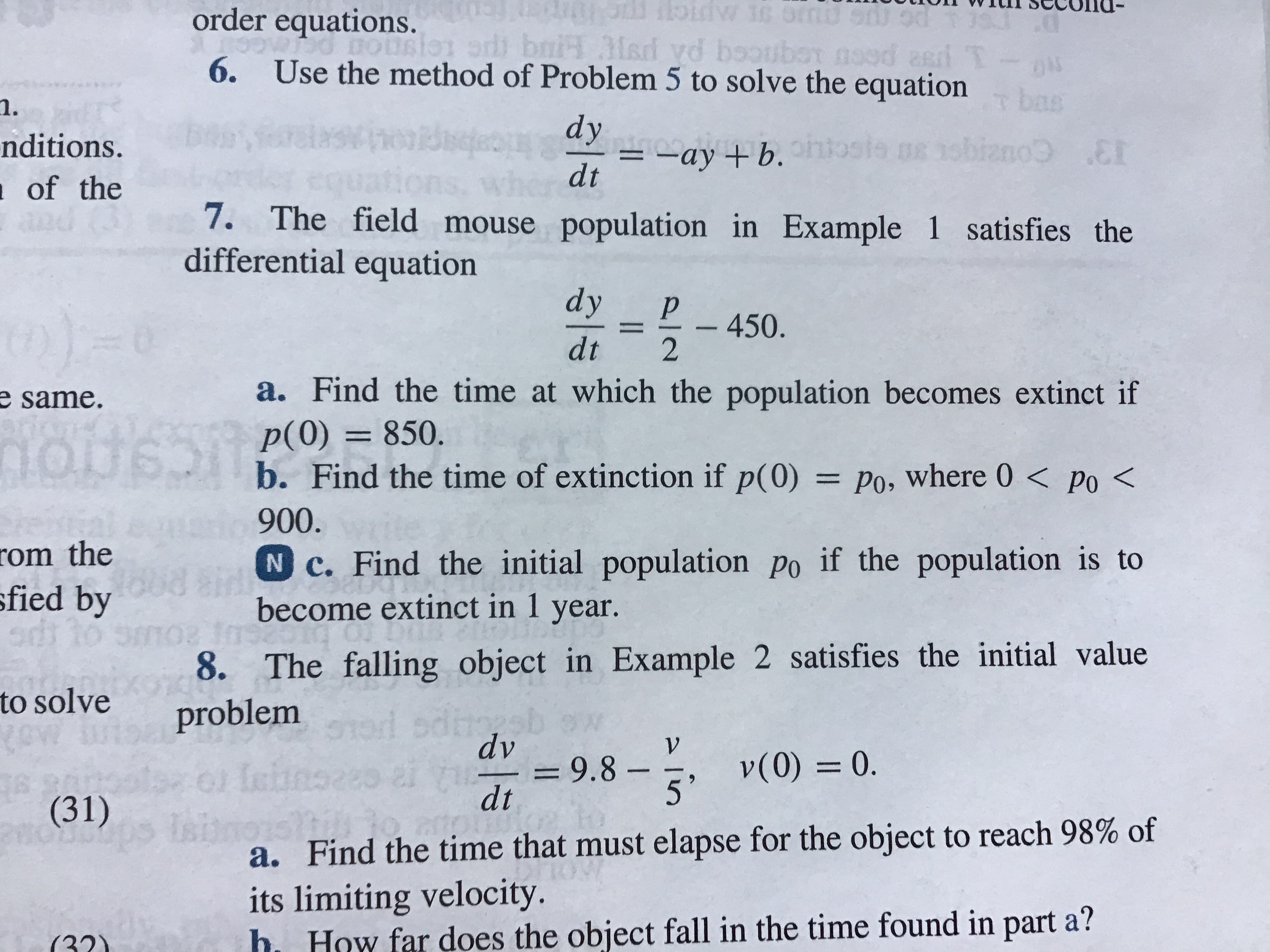tioIn vvrunSecolld- order equations. 6. Use the method of Problem 5 to solve the equation 1. nditions. of the dy dt ayb. 7. The field mouse population in Example 1 satisfies the differential equation dyP 450. dt 2 a. Find the time at which the population becomes extinct if p(O) 850. b. Find the time of extinction if p(0) Po, where 0< po< 900 N c. Find the initial population po if the population is to become extinct in 1 year e same. om the fied by 8. The falling object in Example 2 satisfies the initial value to solve problem dv 9.8 v0) 0 dt (31) a. Find the time that must elapse for the object to reach 98% of its limiting velocity. h How far does the object fall in the time found in part a? (221
tioIn vvrunSecolld- order equations. 6. Use the method of Problem 5 to solve the equation 1. nditions. of the dy dt ayb. 7. The field mouse population in Example 1 satisfies the differential equation dyP 450. dt 2 a. Find the time at which the population becomes extinct if p(O) 850. b. Find the time of extinction if p(0) Po, where 0< po< 900 N c. Find the initial population po if the population is to become extinct in 1 year e same. om the fied by 8. The falling object in Example 2 satisfies the initial value to solve problem dv 9.8 v0) 0 dt (31) a. Find the time that must elapse for the object to reach 98% of its limiting velocity. h How far does the object fall in the time found in part a? (221
Advanced Engineering Mathematics
10th Edition
ISBN:9780470458365
Author:Erwin Kreyszig
Publisher:Erwin Kreyszig
Chapter2: Second-order Linear Odes
Section: Chapter Questions
Problem 1RQ
Related questions
Question
100%
Given the equation dy/dt=(p/2)-450
Find the time of extinction if p(0)=psub0, where 0
This is question number 7

Transcribed Image Text:tioIn
vvrunSecolld-
order equations.
6.
Use the method of Problem 5 to solve the equation
1.
nditions.
of the
dy
dt ayb.
7. The field mouse population in Example 1 satisfies the
differential equation
dyP 450.
dt 2
a. Find the time at which the population becomes extinct if
p(O) 850.
b. Find the time of extinction if p(0) Po, where 0< po<
900
N c. Find the initial population po if the population is to
become extinct in 1 year
e
same.
om the
fied by
8. The falling object in Example 2 satisfies the initial value
to solve problem
dv
9.8 v0) 0
dt
(31)
a. Find the time that must elapse for the object to reach 98% of
its limiting velocity.
h How far does the object fall in the time found in part a?
(221
Expert Solution
This question has been solved!
Explore an expertly crafted, step-by-step solution for a thorough understanding of key concepts.
This is a popular solution!
Trending now
This is a popular solution!
Step by step
Solved in 5 steps with 4 images

Knowledge Booster
Learn more about
Need a deep-dive on the concept behind this application? Look no further. Learn more about this topic, advanced-math and related others by exploring similar questions and additional content below.Recommended textbooks for you

Advanced Engineering Mathematics
Advanced Math
ISBN:
9780470458365
Author:
Erwin Kreyszig
Publisher:
Wiley, John & Sons, Incorporated

Numerical Methods for Engineers
Advanced Math
ISBN:
9780073397924
Author:
Steven C. Chapra Dr., Raymond P. Canale
Publisher:
McGraw-Hill Education

Introductory Mathematics for Engineering Applicat…
Advanced Math
ISBN:
9781118141809
Author:
Nathan Klingbeil
Publisher:
WILEY

Advanced Engineering Mathematics
Advanced Math
ISBN:
9780470458365
Author:
Erwin Kreyszig
Publisher:
Wiley, John & Sons, Incorporated

Numerical Methods for Engineers
Advanced Math
ISBN:
9780073397924
Author:
Steven C. Chapra Dr., Raymond P. Canale
Publisher:
McGraw-Hill Education

Introductory Mathematics for Engineering Applicat…
Advanced Math
ISBN:
9781118141809
Author:
Nathan Klingbeil
Publisher:
WILEY

Mathematics For Machine Technology
Advanced Math
ISBN:
9781337798310
Author:
Peterson, John.
Publisher:
Cengage Learning,

